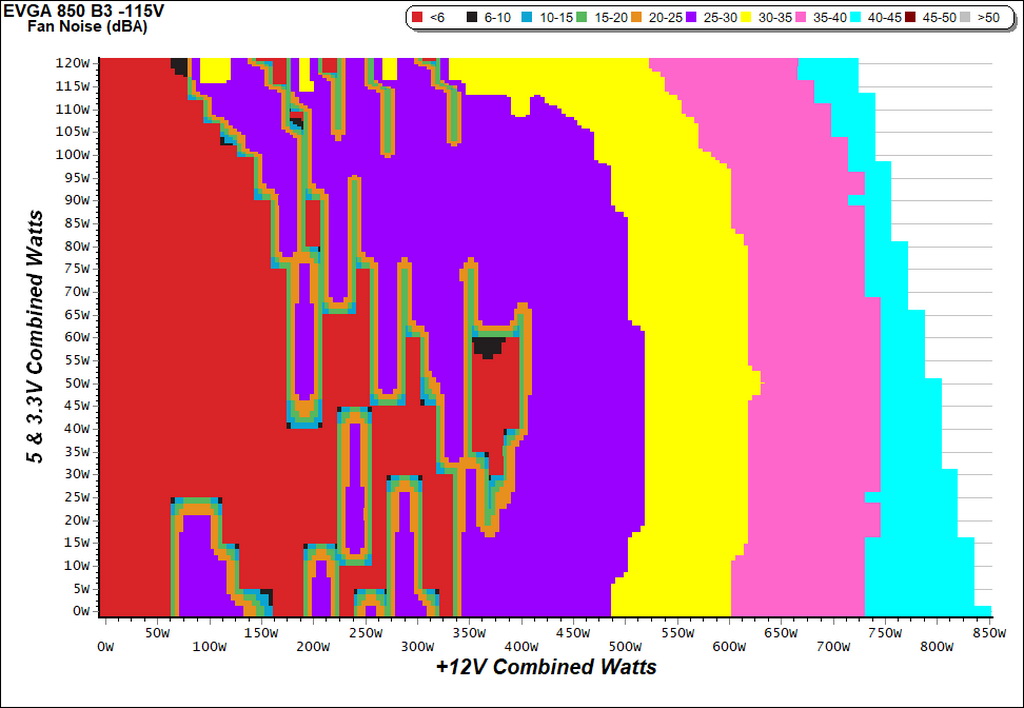EVGA 850 B3 PSU Review
Why you can trust Tom's Hardware
Efficiency, Temperature & Noise
Efficiency
Our efficiency testing procedure is detailed here.
Using results from the previous page, we plotted a chart showing the 850 B3's efficiency at low loads, and loads from 10 to 110 percent of its maximum-rated capacity.

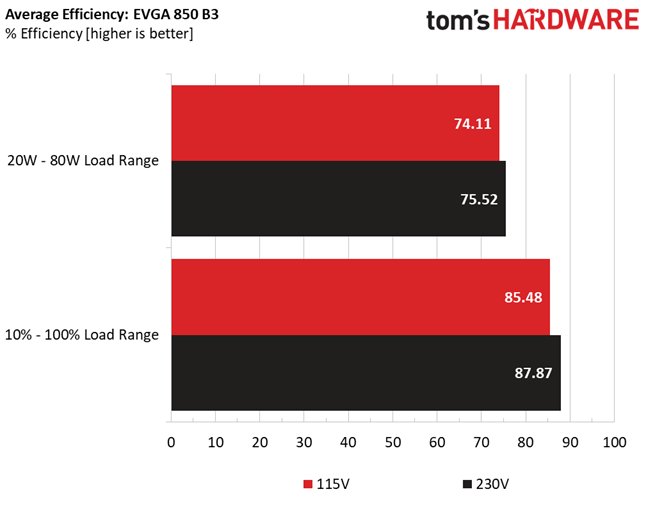

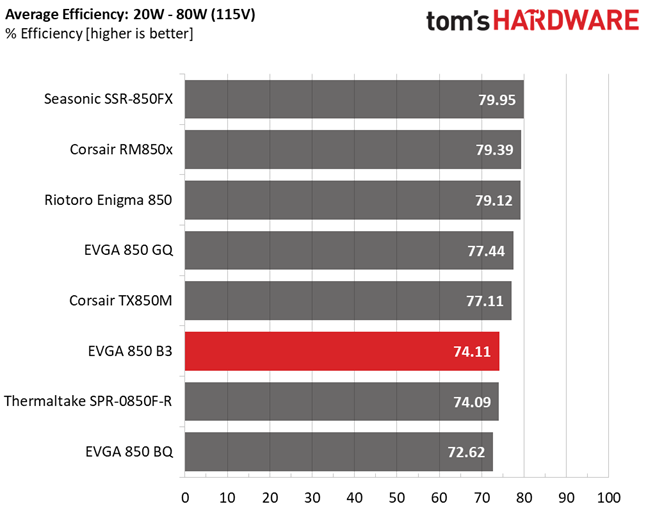
Naturally, the 850 B3 doesn't stand a chance against higher-efficiency platforms. But compared to Thermaltake's lower-end SPR-0850F-R, the EVGA 850 B3 leads under normal and light loads.
Efficiency At Low Loads
In the following tests, we measure the 850 B3's efficiency at loads significantly lower than 10 percent of its maximum capacity (the lowest load the 80 PLUS standard measures). The loads we dialed were 20, 40, 60, and 80W. This is important for representing when a PC is idle, with power-saving features turned on.
| Test # | 12V | 5V | 3.3V | 5VSB | DC/AC (Watts) | Efficiency | Fan Speed | PSU Noise | PF/AC Volts |
|---|---|---|---|---|---|---|---|---|---|
| 1 | 1.200A | 0.493A | 0.478A | 0.192A | 19.629 | 62.453% | 0 RPM | <6.0 dB(A) | 0.834 |
| 12.141V | 5.052V | 3.315V | 5.130V | 31.430 | 115.18V | ||||
| 2 | 2.428A | 0.987A | 0.994A | 0.391A | 39.749 | 75.220% | 0 RPM | <6.0 dB(A) | 0.933 |
| 12.137V | 5.050V | 3.313V | 5.121V | 52.844 | 115.18V | ||||
| 3 | 3.662A | 1.477A | 1.508A | 5.110A | 59.870 | 78.364% | 0 RPM | <6.0 dB(A) | 0.937 |
| 12.133V | 5.048V | 3.312V | 5.110V | 76.400 | 115.18V | ||||
| 4 | 4.881A | 1.985A | 1.990A | 0.781A | 79.789 | 80.384% | 0 RPM | <6.0 dB(A) | 0.951 |
| 12.129V | 5.047V | 3.310V | 5.099V | 99.260 | 115.18V |
As expected, the efficiency we measured under light loads is very low. The only good thing we can say is that the fan doesn't spin, so noise is minimal.
5VSB Efficiency
The ATX specification, along with CEC, ErP Lot 3 2014 and ErP Lot 6 2010/2013, states that 5VSB standby supply efficiency should be as high as possible, recommending 75 percent or higher with 550mA, 1A, and 1.5A of load. The PSU should also achieve higher than 75% efficiency at 5VSB under full load, or with 3A if its max current output on this rail is higher than 3A.
We take six measurements: one each at 100, 250, 550, 1000, and 1500mA, and one with the full load the 5VSB rail can handle.
Get Tom's Hardware's best news and in-depth reviews, straight to your inbox.
| Test # | 5VSB | DC/AC (Watts) | Efficiency | PF/AC Volts |
|---|---|---|---|---|
| 1 | 0.101A | 0.520 | 67.708% | 0.058 |
| 5.138V | 0.768 | 115.15V | ||
| 2 | 0.252A | 1.291 | 74.238% | 0.125 |
| 5.133V | 1.739 | 115.16V | ||
| 3 | 0.542A | 2.776 | 76.727% | 0.227 |
| 5.123V | 3.618 | 115.16V | ||
| 4 | 1.002A | 5.116 | 77.917% | 0.326 |
| 5.107V | 6.566 | 115.16V | ||
| 5 | 1.502A | 7.643 | 78.245% | 0.385 |
| 5.090V | 9.768 | 115.16V | ||
| 6 | 3.001A | 15.097 | 76.790% | 0.465 |
| 5.031V | 19.660 | 115.16V |
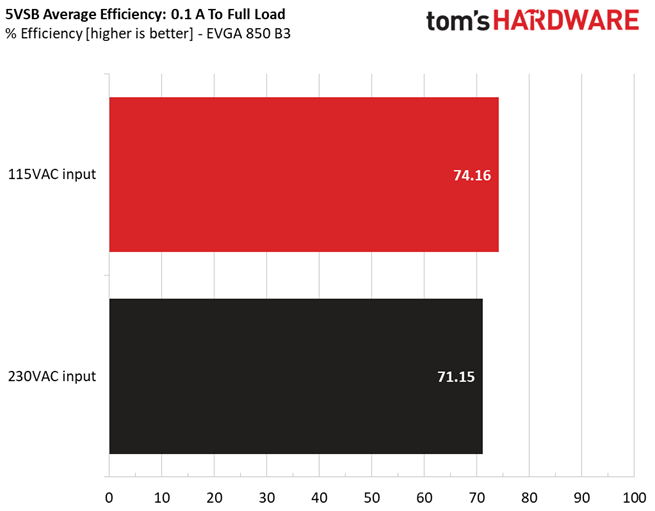
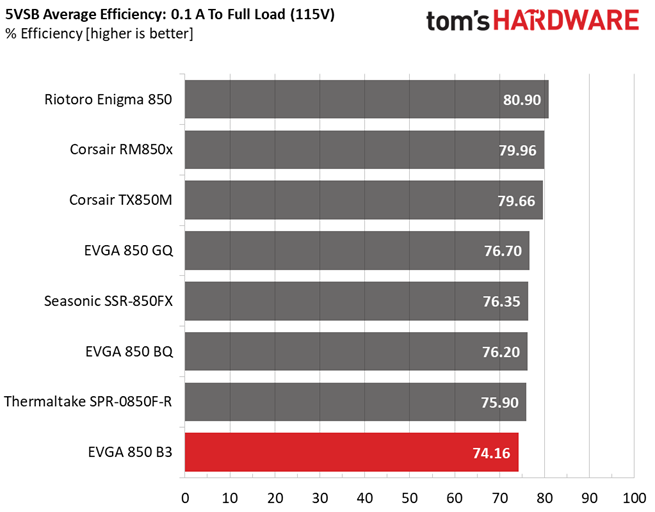
We would like to see higher efficiency levels on this rail.
Power Consumption In Idle And Standby
In the table below, you'll find the power consumption and voltage values of all rails (except -12V) when the PSU is idle (powered on, but without any load on its rails), and the power consumption when the PSU is in standby mode (without any load, at 5VSB).
| Mode | 12V | 5V | 3.3V | 5VSB | Watts | PF/AC Volts |
|---|---|---|---|---|---|---|
| Idle | 12.143V | 5.052V | 3.316V | 5.140V | 10.501 | 0.500 |
| 115.2V | ||||||
| Standby | 0.125 | 0.010 | ||||
| 115.1V |
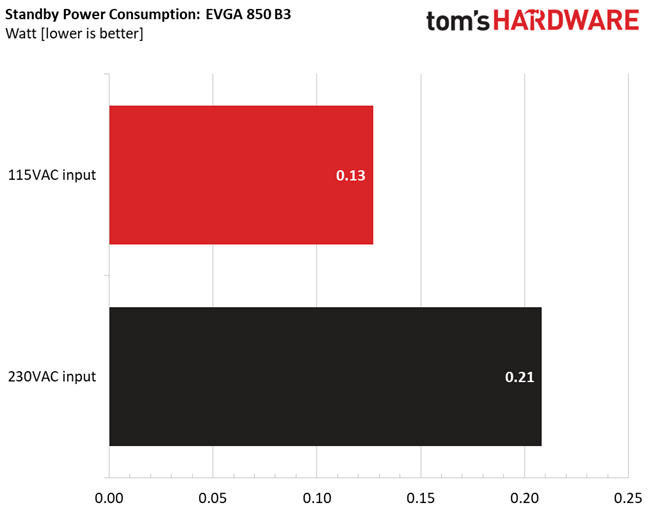
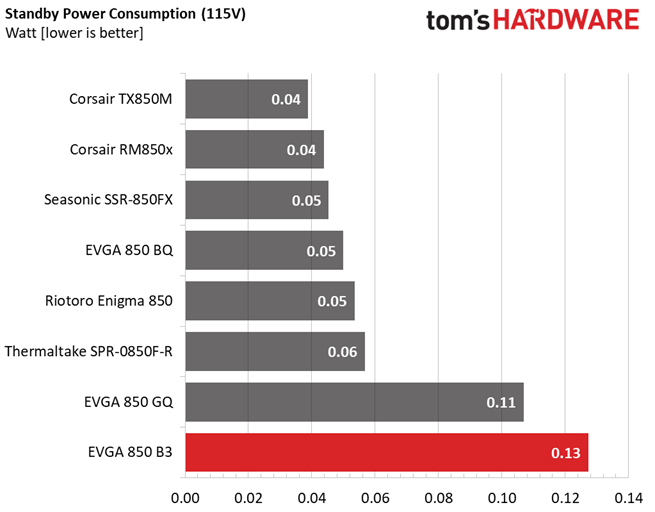
We measure increased vampire power with both voltage inputs. This partially explains the low efficiency at 5VSB under light loads.
Fan RPM, Delta Temperature, And Output Noise
Our mixed noise testing is described in detail here.
The chart below illustrates the cooling fan's speed (in RPM), and the delta between input and output temperature. The results were obtained at 37°C (98.6°F) to 46°C (114.8°F) ambient temperature.
The next chart shows the cooling fan's speed (again, in RPM) and output noise. We measured acoustics from one meter away, inside a hemi-anechoic chamber. Background noise inside the chamber was below 6 dB(A) during testing (it's actually much lower, but our sound meter’s microphone hits its floor), and the results were obtained with the PSU operating at 37°C (98.6°F) to 46°C (114.8°F) ambient temperature.
The following graph illustrates the fan's output noise over the PSU's operating range. The same conditions of the above graph apply to our measurements, though the ambient temperature was between at 30°C (86°F) to 32°C (89.6°F).
EVGA's passive operation is frequently interrupted in order to keep the PSU's internal temperature under control.
With around 490W at +12V, our noise measurements exceed 30 dB(A), while with over 600W they fall within the 35-40 dB(A) range. Finally, it takes more than 730W at +12V to make the fan spin fast enough to generate >40 dB(A).
MORE: Best Power Supplies
MORE: How We Test Power Supplies
MORE: All Power Supply Content
Current page: Efficiency, Temperature & Noise
Prev Page Load Regulation, Hold-Up Time & Inrush Current Next Page Protection Features
Aris Mpitziopoulos is a contributing editor at Tom's Hardware, covering PSUs.
-
orionfotl There's a typo in the Final Analysis: "Although we're glad the 850 B3 didn't blow up like the 450W model, this is our second (so fat) B3-series power supply to die on the bench."Reply
So fat.
Shame on the PSU. -
Realist9 Part of what I got from this review and the associated charts is that my next psu will likely be a Corsair unit.Reply -
dstarr3 It seems like the general wisdom is still "Don't buy a PSU unless it has a 7- to 10-year warranty." The best products from the best OEMs always come with those warranties lately.Reply -
Aris_Mp If you ask me the warranty isn't an indication from the moments it is 5 years long. On the other hand when a company avoids sending some specific PSUs for review, then the whole thing looks suspicious.Reply -
dstarr3 Reply20217010 said:If you ask me the warranty isn't an indication from the moments it is 5 years long. On the other hand when a company avoids sending some specific PSUs for review, then the whole thing looks suspicious.
I don't necessary mean that longer warranty = better product. I just mean that there are some OEMs that are better than the rest, and their best PSUs are the best on the market, and all those best PSUs happen to have 7- to 10-year warranties on them. So if you see that warranty on a PSU right now, you can reasonably assume that it is one of the best models from one of the best OEMs. -
Olle P I don't totally agree with the "Pros" and "Cons":Reply
* Six 8-pin PCIe-connectors are supposed to be capable of delivering up to 900W. This PSU can't handle that.
* The efficiency is as advertised. That's neither a "Con" nor a "Pro". (In fact I'm impressed with the efficiency at 20W load. Expected worse.)
* Sleeve bearing is what makes the fan relatively quiet, so it's not a "Con" per se. Had it been a ball bearing fan you'd written "High noise level" as a "Con" instead. -
Aris_Mp Efficiency is a con in general. It is lowReply
If the fan had DBB and an optimal fan profile then it wouldn't be a con. A sleeve bearing fan in a 100 buck PSU doesn't look good and those type of bearings are suited for horizontal installation so they should normally be avoided in PSUs. -
al3xand3r Hi Aris, congratulations for the wonderful review and all of your work.Reply
I've seen all of your reviews, but one thing I do not understand compared to other review sites and that's related to the advanced transient tests. For example, the be quiet! Pure Power 10 600W PSU, in Advanced Transient Test at +12V, 20% - 20ms has a voltage drop of 0.211V. At 50% load 20 ms is a voltage drop of 0.222 volts. Instead, at ardOCP, the same PSU records a 0.520 volt voltage drop at 20% load - 10 ms and 0.540 volts at 50% load – 10ms. And that's a huge difference. And I do not think this difference is because of the reduced time from 20ms to 10ms because at 1ms wich is tougher the drops it's not as high. What is wrong with ardOCP methodology?
Is it possible that a quality PSU like this to have a voltage drop in load so high (0.52 Volts)? And that's just an example. At all the PSU’s I've seen on both sites are differences like this. Same as when you were doing only 50ms or 200ms. Is there any explanation for these figures that do not coincide?
Thank you


